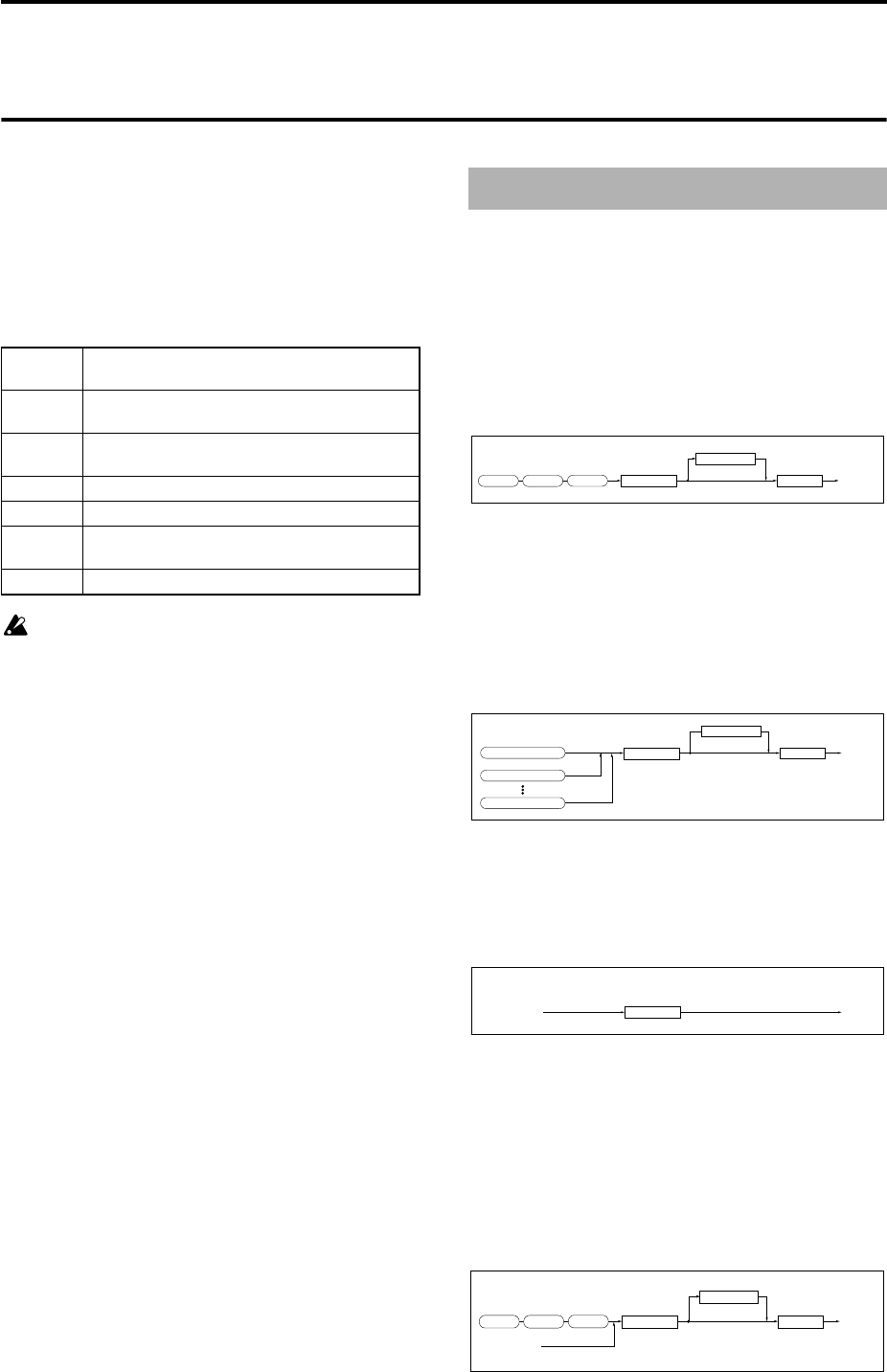
106
Effects settings
The effect section of the TRITON provides five insert
effects, two master effects, one master EQ (stereo 3-
band EQ), and a mixer that controls the routing of
these components.
You can choose from 102 types of full-digital effects for
each insert effect, and from 89 types for each master
effect. The effects are categorized as follows.
Categories of the 102 effect types
Effects 000–089 can be selected for IFX1, 2, 3, 4, 5,
or MFX 1 or 2. Effects 090–102 are double-size
effects, and will use twice the processing area of
other effects. They can be selected for IFX2, IFX3 or
IFX4.
In Program mode, insert effects can be used as part of
the sound-creating process, in the same way that the
output sound of the oscillator (OSC) is processed by
the filter and amp to create the final sound. Then the
master effects can be used to apply spatial-type effects
such as reverb. The stereo 3-band master EQ located
immediately before the OUTPUT (MAIN) L/MONO
and R outputs is used to make final adjustments in
tone. These settings can be made independently for
each program.
In Combination mode, Sequencer mode, and Song
Play mode, insert effects can be used to help create the
sound of each timbre/track. The master effects are
used to apply overall spatial processing, and the mas-
ter EQ is used to make overall adjustments in tone.
These settings are made in Combination mode inde-
pendently for each combination, in Sequencer mode
for each song, and in Song Play mode for the entire
mode.
In Sampling mode, the sound of an external source
that is input from AUDIO INPUT 1 and 2 can be pro-
cessed by the insert effects as the sound is sampled.
Settings in Sampling mode are made in “Audio Input
(Sampling)” of Sampling P0: Input/Setup. These set-
tings are valid only within Sampling mode.
The external input from AUDIO INPUT 1 and 2 can be
used outside of Sampling mode. In Program, Combi-
nation, Sequencer, and Song Play modes, the external
input sound can be processed by the insert effects,
master effects, and master EQ.
This means that you can use the TRITON as a 2-in/6-
out effect processor. When 093: Vocoder is selected, the
TRITON can be used as a vocoder effect processor in
which its internal sounds are controlled by an external
mic input.
001–015 Filter and dynamics effects, such as EQ and com-
pressor
016–031 Phase modulation effects, such as chorus and
phaser
032–040 Other modulation and pitch-shift effects such as
rotary speaker and pitch shifter
041–051 Early reflection and delay effects
052–057 Reverb effects
058–089 Mono + mono chain effects that internally connect
two mono effects in series
090–102 Double-size effects
Effects in each mode
Insert Effect 1-5
Master EQ
Oscillator
Filter
Amplifier
ReturnSend
OUTPUT
L/MONO, R
Master Effect 1,2
Master EQ
ReturnSend
OUTPUT
L/MONO, R
Timbre 1 / Track 1
Timbre 2 / Track 2
Timbre 8 / Track 16
Insert Effect 1-5
Master Effect 1,2
Insert Effect 1-5
Sample
Recording
AUDIO INPUT 1, 2
Insert Effect 1-5
Master EQ
Oscillator
Filter
Amplifier
ReturnSend
OUTPUT
L/MONO, R
Master Effect 1,2
AUDIO INPUT 1, 2


















